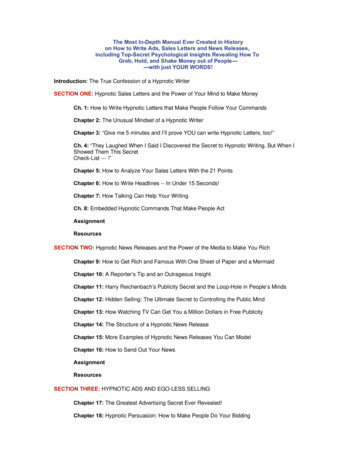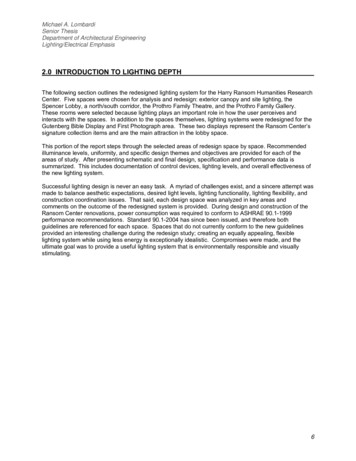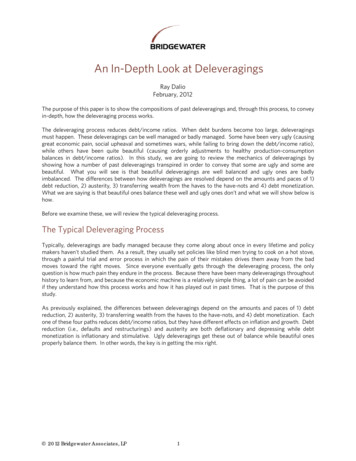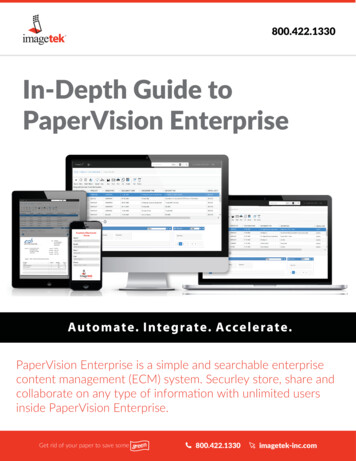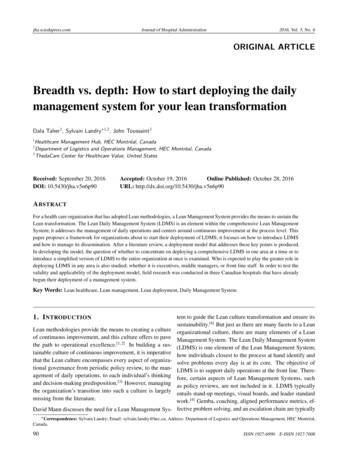
Transcription
jha.sciedupress.comJournal of Hospital Administration2016, Vol. 5, No. 6ORIGINAL ARTICLEBreadth vs. depth: How to start deploying the dailymanagement system for your lean transformationDala Taher1 , Sylvain Landry 1,2 , John Toussaint31Healthcare Management Hub, HEC Montréal, CanadaDepartment of Logistics and Operations Management, HEC Montréal, Canada3ThedaCare Center for Healthcare Value, United States2Received: September 20, 2016DOI: 10.5430/jha.v5n6p90Accepted: October 19, 2016Online Published: October 28, 2016URL: http://dx.doi.org/10.5430/jha.v5n6p90A BSTRACTFor a health care organization that has adopted Lean methodologies, a Lean Management System provides the means to sustain theLean transformation. The Lean Daily Management System (LDMS) is an element within the comprehensive Lean ManagementSystem; it addresses the management of daily operations and centers around continuous improvement at the process level. Thispaper proposes a framework for organizations about to start their deployment of LDMS; it focuses on how to introduce LDMSand how to manage its dissemination. After a literature review, a deployment model that addresses these key points is produced.In developing the model, the question of whether to concentrate on deploying a comprehensive LDMS in one area at a time or tointroduce a simplified version of LDMS to the entire organization at once is examined. Who is expected to play the greater role indeploying LDMS in any area is also studied; whether it is executives, middle managers, or front line staff. In order to test thevalidity and applicability of the deployment model, field research was conducted in three Canadian hospitals that have alreadybegun their deployment of a management system.Key Words: Lean healthcare, Lean management, Lean deployment, Daily Management System1. I NTRODUCTIONLean methodologies provide the means to creating a cultureof continuous improvement, and this culture offers to pavethe path to operational excellence.[1, 2] In building a sustainable culture of continuous improvement, it is imperativethat the Lean culture encompasses every aspect of organizational governance from periodic policy review, to the management of daily operations, to each individual’s thinkingand decision-making predisposition.[3] However, managingthe organization’s transition into such a culture is largelymissing from the literature.David Mann discusses the need for a Lean Management Sys-tem to guide the Lean culture transformation and ensure itssustainability.[4] But just as there are many facets to a Leanorganizational culture, there are many elements of a LeanManagement System. The Lean Daily Management System(LDMS) is one element of the Lean Management System;how individuals closest to the process at hand identify andsolve problems every day is at its core. The objective ofLDMS is to support daily operations at the front line. Therefore, certain aspects of Lean Management Systems, suchas policy reviews, are not included in it. LDMS typicallyentails stand-up meetings, visual boards, and leader standardwork.[4] Gemba, coaching, aligned performance metrics, effective problem solving, and an escalation chain are typically Correspondence: Sylvain Landry; Email: sylvain.landry@hec.ca; Address: Department of Logistics and Operations Management, HEC Montréal,Canada.90ISSN 1927-6990E-ISSN 1927-7008
jha.sciedupress.comJournal of Hospital Administrationincorporated as well.[5, 6] This paper addresses this dailyaspect of the Lean Management System, as highlighted byMann,[4] and seeks to develop a framework for health careorganizations that are considering or have already startedtheir Lean journey but have not yet deployed LDMS.2. LDMS DEPLOYMENT LITERATUREREVIEWEven though there is no extensive research on LDMS deployment, there is literature on related management approaches,such as Total Quality Management (TQM). Most of the research concludes that such an implementation of a management approach is organization-specific.[7] As a general rule,most implementation plans tend to be broken down intophases in order to manage the extensiveness and complexityof such an undertaking. The first recommended phase isto establish “proof of concept”, which is examined in thefollowing section. The subsequent sections address the breaking down of the deployment effort; the spread of LDMS inbreadth and depth throughout an organization, and the forceof change within each department.2.1 Proof of conceptIt is recommended that the organization initiate its deployment effort in a controlled area in order to test strategies,learn what works, and showcase outcomes to the organization.[8] Showcasing a successful deployment can also bethought of as making the case for LDMS in an attempt toconvince the organization as a whole to adopt it. This isoften referred to as “proof of concept”; it combats resistancewithin organizational members. A model cell, one way todeploy LDMS in a controlled area, provides this proof ofconcept. The proposed model cell may also be described asa “living model” as it is dynamic and evolving. It allows theorganization to not only witness the outcomes of the introduction of LDMS to the controlled area, but to also follow itsevolution as Lean becomes further ingrained in the mindsetof area members. Toussaint describes the model cell as botha “center where people can experiment with ideas” as wellas a “demonstration exhibit”.[9]2016, Vol. 5, No. 6development method, which may not lend itself well to theinherit evolutionary nature of developing an organizationalmindset.[11]2.2 Breadth vs. depthDeployments can be categorized into company-wide deployments (mile-wide inch-deep), focused deployments (inchwide mile-deep), and partial deployments that target particular issues throughout the organization.[8] Company-widedeployments are often referred to as mile-wide inch-deepbecause it targets a certain hierarchical level within the entireorganization, such as all executive management. Accordingto that categorization, the mile-wide inch-deep approach prioritizes the breadth of LDMS deployment, rather than itsdepth. It entails deploying a simplified version of LDMS,or some aspect of it, throughout the entire organization simultaneously. An example of this approach would be toonly introduce stand-up meetings throughout the organization. Theoretically, introducing one LDMS element at a timewould enable organizational learning through this shared experience and slowly build a Lean mindset. However, LDMSis a comprehensive system with elements that feed off of oneanother. Conducting effective stand-up meetings is contingent upon having a well-developed visual board that displaysproper performance indicators and initiatives that aim to improve performance.[4] Not having the needed inter-elementconnections makes conducting such meetings more difficult,unsustainable, somewhat aimless, and could cause undueburden on organizational members.At the opposite end of the breadth vs. depth spectrum, theinch-wide mile-deep approach entails the creation of a comprehensive LDMS on a smaller scale, within a single department, for example. It should be noted that the modelcell is essentially an inch-wide mile-deep application in acontrolled area. The same method of deploying LDMS inthe model cell can be used to roll out the deployment to therest of the organization. By granting the ability to experienceLDMS first hand on a smaller scale, the inch-wide mile-deepapproach minimizes the threat and cost of failure. It alsoprovides further proof of concept by creating more deploySimilar to the model cell, a pilot area is another alternative ment areas and success stories to use as showcases. Thisto start the LDMS deployment; it also enables the testing of reduces resistance and allows for LDMS’ smooth adoption[9, 12]strategies and demonstration of proof of concept.[8, 10] The in subsequent departments.distinction between them is that the model cell involves an ongoing process of testing and showcasing outcomes, whereas 2.3 Path of influencethe pilot area emphasizes the testing of deployment strate- In addition to determining the focus of the deployment, thegies. Unlike the model cell, the pilot area is not maintained direction of deployment in whichever approach is chosenand continuously examined, but is rather just the first of a (mile-wide inch-deep or inch-wide mile-deep) must be examseries of implementations. The implication of choosing a ined as well. This refers to where deployment is to start in thepilot area rather than model cell is that it is not an ongoing organizational hierarchical structure, within the organizationPublished by Sciedu Press91
jha.sciedupress.comJournal of Hospital Administration2016, Vol. 5, No. 6as a whole or just the department where the deployment is ideal candidates to spearhead the deployment of LDMS in ainitiated, as well as the trajectory of transformation as LDMS third alternative direction; the middle-out.[15] Middle manis spread.agers’ influence on the front line staff enables them to guidethe transition into a Lean mindset of continuous improveCertainly, in most readers’ minds, the assumed path is ament at the process level. Their continuous interaction with“top-down” direction from executives to front line workers.leadership allows them to synthesize information and guideAfter all, executive managers create the policy to adopt a newleadership towards change that is sustained at the front line.management system. Leadership, in general, exerts greatThemiddle-out approach is therefore bi-directional since theinfluence on the organization’s culture.[1] Developing keymiddle managers are able to simultaneously influence bothcompetencies in leaders thus becomes pivotal, and leadershipexecutives and front line employees through different means.behaviors that sponsor a Lean environment must be demonstrated consistently for any chance of success.[4] In such 2.4 LDMS deployment modelan approach, upper management is expected to exert their In order to depict the key findings from the literature reinfluence on middle managers; middle managers, in turn, view, the LDMS deployment framework was developed (seeexert their influence on the front line staff. This approach Figure 1); it breaks down the deployment effort accordingis expected to yield high executive commitment since upper to the different decision options that were presented. Theand middle management become involved in the deployment model depicts the proposed alternative based on the literaof LDMS. In turn, changes at the front line can only occur ture review. It recommends starting the deployment effortonce executives successfully understand the Lean mindset, with a model cell as a proof of concept. Subsequently, anand are able to successfully convey it to middle managers.inch-wide mile-deep approach is recommended to spreadOn the flipside, without the collaboration of the front linestaff, LDMS cannot create the management structure at theprocess level, which makes it an imposing layer of management rather than a comprehensive management system.Therefore, a bottom-up approach is sometimes suggestedbecause of its inclusiveness and employee empowerment.This approach calls for managers to provide the front linestaff members with enough leeway that allows the front lineto develop a new mindset. So management involvement isstill needed in this case, however, it is a passive involvement.A successful LDMS deployment in this approach is contingent on the front line taking the initiative and fostering thediscipline needed to develop LDMS from the ground up. Bydeveloping a new mindset at the front line, this approach anticipates the staff members to influence how middle managersinteract with them. For example, having front line employeesdevelop their own visual boards and stand-up meetings empowers them to assume ownership of the process and workeffectively towards reaching their performance objectives.As they start to show results, they can influence middle managers who, in turn, are able to influence upper managementby demonstrating how LDMS enabled the improvement oforganizational performance metrics.In both deployment directions (top-down and bottom-up), theinfluence of middle managers is somewhat undermined. Yet,research indicates that middle managers are well positionedto affect process change through their ongoing interactionswith front line staff. Meanwhile, their direct reporting to executive management allows them to convey updates upwardsand strategy downwards.[13, 14] This makes middle managers92LDMS throughout the organization. Within each area, directing change at middle managers in a middle-out approach isrecommended.Figure 1. LDMS deployment model3. C ASE STUDIESIn order to test the validity and applicability of the proposeddeployment model, case studies of three Canadian hospitalswere conducted in 2014. All three hospitals, Hospital A,B and C, were deploying LDMS through different means;Toyota Kata[5] was the inspiration for one, and ThedaCare(WI, USA) methodology for the other two hospitals. The hospitals are in different stages in their Lean journeys in termsof implemented improvement initiatives. Also, the differentprovinces they represent ads another layer of variation sinceadministrating and delivering health care services in Canadais a provincial responsibility. Sometimes called theoreticalsampling, these cases represent different contexts that offer insights rather than comparisons.[16] An embedded casestudy was conducted for each hospital; two departments wereundertaken as units of analysis. The model derived from theliterature review was used in the development of the replication logic, which ensured the same aspects of LDMS areISSN 1927-6990E-ISSN 1927-7008
jha.sciedupress.comJournal of Hospital Administration2016, Vol. 5, No. 6examined in each case. During the data collection week for like in the end in terms of organizational goals and culture.each case, the same participants were observed and probed (2) The perceived role and value of LDMS seemed to haveat different time periods to achieve triangulation.had the greatest consequence on how each organization choseto deploy it. Organizational member’s understanding of the3.1 Research methodologysignificance of deploying LDMS influenced their participa3.1.1 Observationtion in its deployment. If LDMS was perceived to be a meansA total of 12 hours of observation including nine stand-up to manage improvements, as it is in Hospital B, leadershipmeeting observations were conducted, each lasting roughly involvement is not as critical as it is in Hospital C, whose30 minutes. These meetings provided the opportunity to ob- intended role of LDMS is the enablement of organizationalserve the interaction between hierarchical tiers and within the transformation. On the other hand, Hospital A’s intendedsame tier at the front line level. In most cases, observation LDMS role is to drive performance, making its deploymentwas followed by an interview to obtain a greater depth of at the front line necessary as it is at the leadership level.understanding of the observed processes.3.2.1 Model cell proof of concept3.1.2 Individual interviewsAll three hospitals had pilot areas, which were simply theA total of 25 interviews were conducted using open-ended initial deployment areas, although Hospital B did make somequestion-sets. In addition to front line staff members, a total alterations to their deployment program as a result of theof two executives, four directors, and five middle managers feedback obtained from these pilot areas. However, sincewere interviewed. Although the makeup of the interviewees none of the three organizations utilized a model cell in theirdiffered among the three hospitals, the number of formal in- deployment, an analysis of the merits of having a model cellterviews was evenly spread. These interview sessions varied cannot be conducted.in length, ranging from 30 minutes to two hours. Short and3.2.2 Inch-wide mile-deep deployment focusinformal interviews were also conducted with some frontHospital B adopted the inch-wide mile-deep approach inline staff members. These five minute informal interviewsdeploying all the elements of their management system aswere conducted during observation sessions and the quesa complete package in each department. For each departtions pertained to the process being performed.ment, a 20-week programmed implementation allowed for3.1.3 Documentationthe comprehensive transference of knowledge, and transitionA wide assortment of documents was consulted, such as pre- to subsequent departments. This focused approach led tosentation slides, training material, standard work documents, very noticeable changes at the operational level within eachas well as templates and manuals. The objective was for the department and led to a systematic and fast pace deployment.researcher to recognize the traces of the transformation, andOn the other hand, Hospital C undertook a mile-wide inchidentify the conditions and factors that led to the outcomesdeep approach in order to create change one hierarchicalthat transpired.level at a time from the top-down. They recognized theprolonged timeframe needed to expand LDMS to include3.2 Findings & analysismiddle managers as well, but are banking on leadership’sIn order to validate the LDMS Deployment Model (see Figability to influence their mindset and build a culture of conure 1), this section highlights the main findings from thetinuous improvement. As an outcome, leaders expressedcase studies, according to the main decision points depictedthat they are now on board with the transformation; theyin the model. There are two key points worth noting thatattest to its value, and some have informally extended LDMSultimately affect these findings: (1) Each organization hadto middle managers. However, this executive commitmenta different interpretation of what LDMS’s value or role is.is not necessarily translating to a culture of continuous imThe role of LDMS can be defined as the main objectiveprovement throughout the organization since LDMS has notof deploying it. LDMS elements, such as visual boards andyet been introduced to the front line. It is also noteworthystand-up meetings, seem to be universal. However, taking thethat even though the management system crosses all departvisual boards as an example, how these boards should look,mental boundaries, the silo mentality was still evident aswho is responsible for them, how they are utilized, and whatleaders expressed that inter-department collaboration is notinformation should be posted on them differs among the orgatranspiring.nizations. The value or role each organization placed on theirrespective LDMS ultimately shaped how LDMS elements At Hospital A, the approach can be described as a hybridfunctioned separately and collectively. It also shaped how because a mile-wide inch-deep deployment was commencedeach organization envisioned what their LDMS should look for upper management, while an inch-wide mile-deep betPublished by Sciedu Press93
jha.sciedupress.comJournal of Hospital Administrationter describes how LDMS was deployed within departments.This dual approach (breadth & depth) reaped the rewardsfrom both approaches; leadership commitment (from themile-wide inch-deep top-down approach) as well as operational improvements at the front line process level (from theinch-wide mile-deep approach).2016, Vol. 5, No. 6in Figure 2 depicts the organization is heading towards amile-wide mile-deep deployment, but is not there yet.Hospital A initially started its LDMS deployment at the middle manager level with an inch-wide mile-deep approachbefore shifting to a mile-wide inch-deep approach at theexecutive and director levels (leadership) in order to capture management commitment. This is depicted with theconsiderable movement along the breadth vs. depth matrixfrom a strictly inch-wide mile-deep approach to a mile-wideinch-deep approach. Now that LDMS has been introducedto leadership, the organization finds itself at a juncture as itseeks to recapture an inch-wide mile-deep approach withineach department.To further examine how each organization’s approach tallied,Figure 2 depicts the trajectory of LDMS deployment in eachorganization as a whole. The “X” marks where the organization started its LDMS deployment along the breadth vs.depth matrix. The circles indicate where the organization,in its entirety, was in terms of its LDMS deployment at thetime of the data collection. Reviewing each organization’sLDMS deployment trajectory enables us to visualize how theBuilding on the analysis of these trajectories, a recommendadeployment focus decision (breadth vs. depth) shapes thetion was developed to enable organizations to draw their ownoverall spread of LDMS throughout the organization.trajectory towards the ultimate goal of a deployed LDMSthat embraces every aspect of organizational culture andactivities (see Figure 2). Figure 3 depicts the suggested trajectory towards that goal of full breadth and depth (mile-widemile-deep). While Hospital B showed tremendous ability ofprogressing towards a mile-wide mile-deep deployment, itwas still missing the leadership involvement and alignmentthat was captured in the other two hospitals. If leadershipinvolvement were to be added as a precursor, it would notonly facilitate the deployment of LDMS, but would also ensure its sustainability. Therefore, after a mile-wide inch-deepdeployment approach at the upper management or leadershiplevel, the next phase would be to transition into an inch-widemile-deep approach in departments that are enrolled in aFigure 2. LDMS deployment focus trajectories of 3cascading fashion. The pace at which the transition fromhospitalsmile-wide inch-deep to inch-wide mile-deep will ultimatelydepend on various organizational-specific factors such as theBoth Hospitals B & C adopted straightforward paths to over- organization’s size and culture. As more of these departall LDMS adoption. Hospital B implemented an inch-wide ments are enrolled, the breadth of LDMS would be enhancedmile-deep approach in 4 areas simultaneously before moving to the point where the organization has a system that is mileon to other areas. As more departments were enrolled into wide mile-deep. This trajectory is showcased in Figure 3; thethe program, the number of departments multiplied. The sequence of phases is also included for simplicity.result is that all inpatient units have a comprehensive man3.2.3 Middle-out path of influenceagement system deployed in terms of breadth and depth.Both Hospitals A and C adopted a top-down approach inTherefore, the organization as a whole is now closer to bedeploying LDMS. While the intended change was processing mile-wide mile-deep. Hospital C’s opposite approachoriented at Hospital A, a strategic change was the objective at(mile-wide inch-deep) has also led the organization towardsHospital C. In both cases, the hypothesis was that upper mana mile-wide mile-deep implementation of LDMS. With theagement would influence how their subordinates adapted toentire leadership team on board with LDMS, the next stepthe change of culture and strategy. As a result of this strategy,would be to involve all middle managers, and from thereon,management commitment was evident in both cases.the entire front line staff. However, since Hospital C’s milewide inch-deep deployment has only been formally extended Hospital B utilized middle managers to spearhead the deployto the executive and director levels (leadership), the hospi- ment of LDMS in each department. The objective was to protal as a whole is moving towards the mile-wide mile-deep duce operational improvement at the front line, as well as thedeployment at a much slower rate. Therefore, the trajectory ensuing change in culture. However, a concern that has mate94ISSN 1927-6990E-ISSN 1927-7008
jha.sciedupress.comJournal of Hospital Administrationrialized at Hospital B is that middle managers have a greaterinfluence on the front line, their subordinates, than they havewith upper management, their superiors. A culture of continuous improvement was built at the front line, but alignmentwith high-level organizational objectives was not achievedbecause executives were not truly involved. This suggeststhat targeting change at the middle management level is morelikely to yield changes from the middle-down than middle-up.Yet, Hospitals A & C demonstrate the importance of gainingupper management commitment and involvement in orderto enable the strategic and cultural change that LDMS needsto thrive. The role of leadership is pronounced in so manyways, from committing resources to changing the attitudes oforganizational members. This underlines the need to separatethe upper management from the general deployment effort;some time needs to be dedicated to building competenciesand capabilities at the leadership level, thus enabling uppermanagement to undertake the responsibility of deployingLDMS.2016, Vol. 5, No. 6Figure 4. LDMS deployment frameworkThis transition of the focus of LDMS deployment createsa “T” shaped model. It entails the development of broadknowledge at the top and deep knowledge in organizationallevels within the department. Upper management forms thebar, while middle managers and front line staff form the baseof the framework.4. C ONCLUSIONSFigure 3. Recommended LDMS deployment trajectoryUltimately, hospitals can’t improve without using better management systems.[17] Managing the Lean transformationshould not be limited to doing Lean projects.[18, 19] The management system serves to guide this Lean transformationthrough continuous improvement towards improving qualityof care and patient satisfaction, and reducing costs.A hybrid of both top-down and middle-out approaches, whilenot demonstrated in any of the cases, is recommended, asopposed to a top-down & bottom-up hybrid, because it stillemphasizes the seminal role of middle managers; the top- The proposed “T” shaped LDMS deployment frameworkdown addition only ensures that middle-managers have the focuses on how to introduce LDMS and how to manageleadership commitment that they need in order to succeed. its spread. Based on our research, we recommend healthcare organizations to adopt a mile-wide inch-deep top-down3.3 LDMS deployment frameworkapproach at the leadership level before transitioning to anBuilding on the LDMS Deployment Model (see Figure 1) inch-wide mile-deep middle-out approach within each deand the ensuing analysis from the multiple case studies, the partment. It is the researchers’ opinion that the deploymentaugmented framework was developed (see Figure 4). The of LDMS needs to be as meticulous and structured as themost notable change in the framework from Figure 1 is the design of its elements. The details of the implementationrecommendation to adopt a mile-wide inch-deep top-down plan will ultimately depend on the organization’s experienceapproach at the leadership level before transitioning to an with Lean.inch-wide mile-deep middle-out approach within each department. This recommendation is in line with the analysis C ONFLICTS OF I NTEREST D ISCLOSUREand inference in Figure 3.The authors declare they have no conflicts of interest.Published by Sciedu Press95
jha.sciedupress.comJournal of Hospital AdministrationR EFERENCES[1] Liker JK, Convis GL. The Toyota Way to Lean Leadership: Achieving and Sustaining Excellence Through Leadership Development.New York, NY: McGraw-Hill; 2011. PMid: 21967279.[2] Zarbo RJ. Creating and Sustaining a Lean Culture of Continuous Process Improvement. American Society for Clinical Pathology. 2012;138: 321-326. PMid: 22912347. http://dx.doi.org/10.1309/AJCP2QY1XGKTSNQF[3] Hines PA, Found P, Griffiths G, et al. Staying Lean: Thriving,Not Just Surviving (second ed.). New York, NY: CRC Press; 2011.http://dx.doi.org/10.1201/b10492[4] Mann D. Creating a Lean Culture: Tools to Sustain Lean Conversions(third ed.). Boca Raton, FL: Productivity Press; 2014.[5] Rother M. Toyota Kata: Managing People for Improvement, Adaptiveness and Superior Results. New York, NY: McGraw-Hill Professional Publishing; 2010.[6] Sehested C, Sonnenberg H. Lean Innovation: A Fast Path fromKnowledge to Value. Horsholm, Denmark: Springer; 2011.[7] Ghobadian A, Gallear D. TQM Implementation: An Empirical Examination and Proposed Generic Model. Omega. 2001; 29(4): 030-5[8] Duarte B, Montgomery D, Fowler J, et al. Deploying LSS in a GlobalEnterprise - Project Identification. International Journal of Lean SixSigma. 2012; 3(2): 187-205. http://dx.doi.org/10.1108/20401461211282709[9] Toussaint J. Management on the Mend: The Healthcare ExecutiveGuide to System Transformation. Appleton, WI: ThedaCare Centerfor Healthcare Value; 2015.[10] Bansler JP, Havn E. Pilot Implementation of Health InformationSystems: Issues and Challenges. International Journal of Medi-962016, Vol. 5, No. 6cal Informatics. 2010; 79(9): 637-648. PMid: 20576466. 1] Bessant J, Caffyn S, Gallagher M. An Evolutionary Model of Continuous Improvement Behaviour. Technovation. 2001; 21(2): 3-7[12] Ahire SL, Rana DS. Selection of TQM Pilot Projects Using anMCDM Approach. International Journal of Quality & ReliabilityManagement. 1995; 12(1): 61-81. http://dx.doi.org/10.1108/02656719510076258[13] Embertson MK. The Importance of Middle Managers in HealthcareOrganizations. Journal of Healthcare Management. 2006; 51(4): 223232. PMid: 16916116.[14] Salih A, Doll Y. A Middle Management Perspective on StrategyImplementation. International Journal of Business and Management.2013; 8(22): 32-39. http://dx.doi.org/10.5539/ijbm.v8n22p32[15] Mintzberg H. Rebuilding Companies as Communities. Harvard Business Review. 2009;
David Mann discusses the need for a Lean Management Sys-tem to guide the Lean culture transformation and ensure its sustainability.[4] But just as there are many facets to a Lean organizational culture, there are many elements of a Lean Management System. The Lean Daily Management System (LDMS) is one elemen


